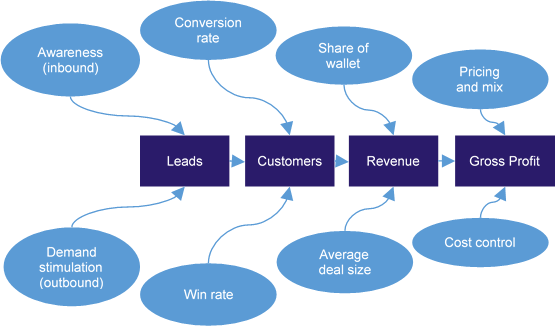
Inside the World of the Chief Sales Officer (CSO)
As featured in Training Journal
As an L&D professional, one of the most direct ways you can help to improve your company’s sales performance is by improving its sales capability. Win rates, average deal sizes and prices all have a dramatic effect on the bottom line, and provide superb measurement data for ROI.
However, if we’re to add value to sales leaders, we need to understand their world-view, and what they are trying to achieve.

Sales Objectives
In the broadest sense, the Chief Sales Officer (or equivalent) is responsible for the commercial performance of the business. This starts with the number of leads generated, which allows customers to be won, who in turn drive revenue growth, and ultimately gross profit.
At each stage, the CSO can pull a number of levers, shown as ovals in the diagram below. These levers range from how well the team stimulates demand, to how well leads are converted into opportunities and then won, to how big the deals are and how much share of wallet we can retain in our existing accounts, and so on.

All of these metrics form KPIs that the CSO can be measured on. In order to improve those metrics, the CSO works at two levels: strategic and tactical.
Sales Strategy
Sales strategy is all about deciding where the sales team is going to be active, and how it will perform better than the competition in its chosen area of focus. This ‘how’ dimension is where L&D can help the most, and it is focused on three main issues:
- Improving the assets (human and otherwise) in the sales team. This includes the quality and type of staff, how well they fit with the needs of the market, and how they are hired, retained, incentivised and organised;
- Building relationships with channels and other partners in the sales ecosystem;
- Strengthening the capabilities of the sales team, and other adjacent teams by embedding an effective sales methodology, aligning product training with that methodology, and equipping and motivating sales managers to coach their teams.
This sales strategy is constantly evolving in the light of changes in demand, competition, technology, regulation, and the company’s own strategy and objectives.
Sales Tactics
To implement the strategy, salespeople and sales managers need a range of tactical skills aligned with the levers noted above. The strategy will dictate which tactical issues are the most important.
This is where training needs are typically most obvious, for example in launching a new product, or improving win rates.
There are also tactical goals where coaching is the answer, for example coaching teams around what we call ‘must-win deals’ and ‘must-grow accounts’.
Cross-functional collaboration and analytical skills are crucial in refining the sales process and ensuring optimal performance. This involves understanding and leveraging customer relationship management tools and enhancing communication skills within the team.
Finding Sweet Spots
Each of these sales objectives is a potential area where L&D can help. If you haven’t already, talk to your sales leaders about their objectives and priorities, then help them to see the ‘sweet spots’ where you can add the most value.
Author, Richard Barkey is the founder & CEO of Imparta Ltd., the global sales and service training company. Richard is an expert in sales and learning, and a pioneer in the field of business simulations. To discuss any of these issues, please contact us.